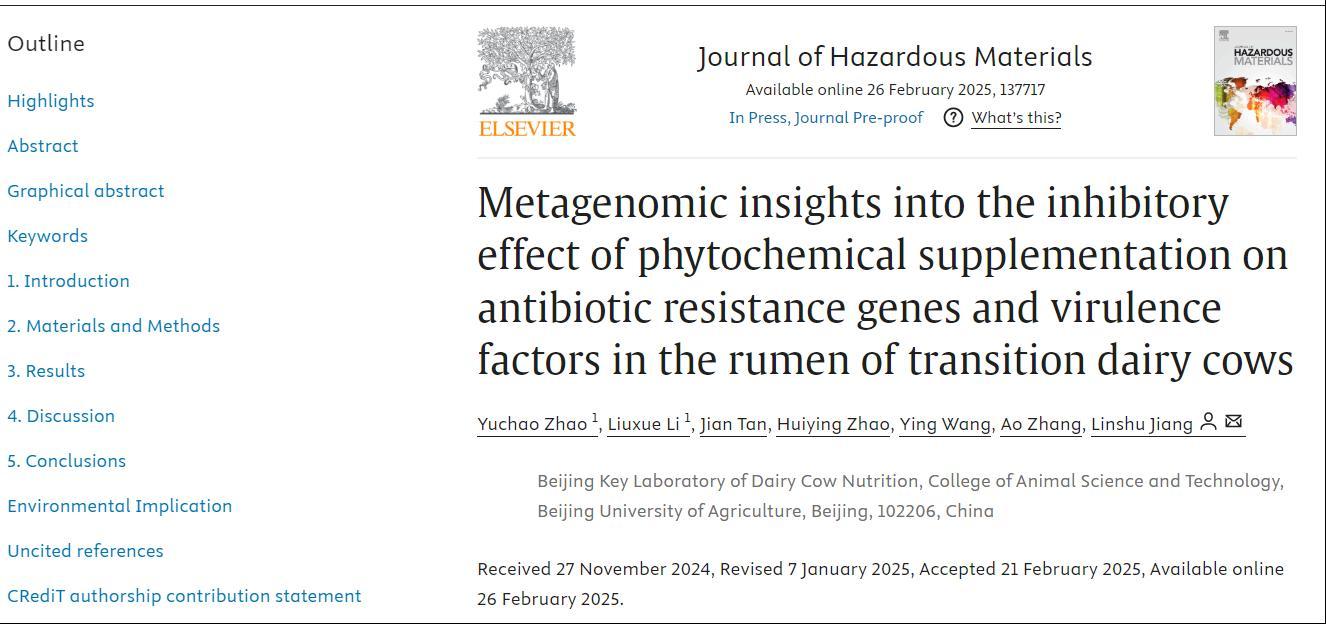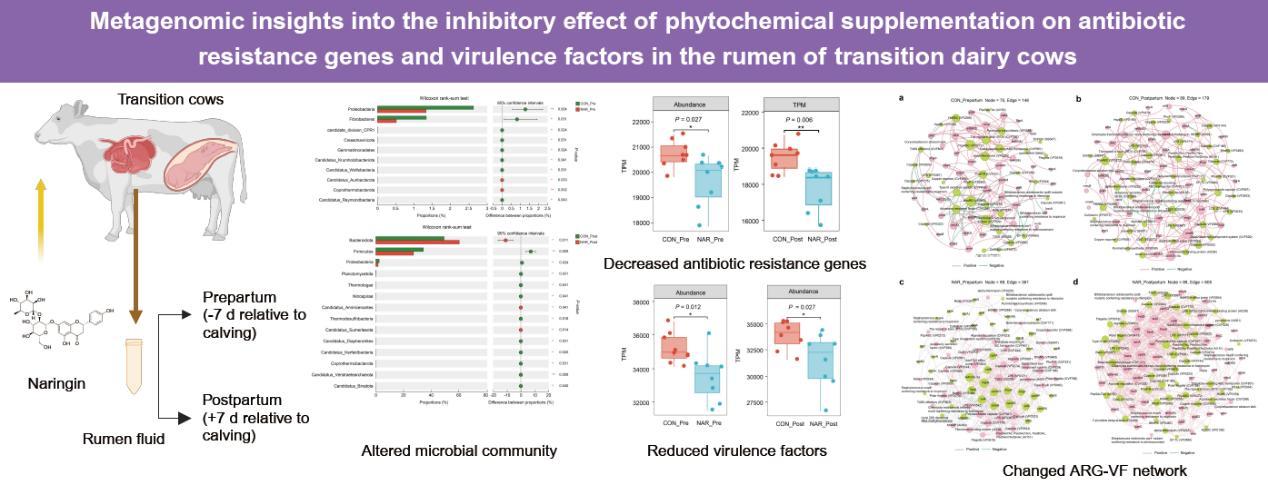Recently, the research team led by Professor Linshu Jiang of our university has published an online research paper titled "Metagenomic insights into the inhibitory effect of phytochemical supplementation on antibiotic resistance genes and virulence factors in the rumen of transition dairy cows" in the international academic journal Journal of Hazardous Materials (a top journal in the first division of the Chinese Academy of Sciences, with an impact factor of 12.2). This study uses transition dairy cows as the research model to explore the effects and mechanisms of adding naringin to the diet on rumen resistance genes and virulence factors, providing a theoretical basis for the development of plant-derived feed additives to improve rumen function and reduce the diffusion of resistance genes and virulence factors into the environment. Associate Professor Yuchao Zhao from the College of Animal Science and Technology and the graduated postgraduate Liuxue Li(currently a doctoral student at Nanjing Agricultural University) are the co-first authors of the paper, and Linshu Jiang is the corresponding author of the paper. This research has been funded by the National Natural Science Foundation of China and the Natural Science Foundation of Beijing.

It is reported that antibiotic resistance has been listed by the World Health Organization as one of the top ten global public health threats. The widespread use of antibiotics in the livestock industry has turned the animal gut into a "repository" of resistance genes, which may spread to the environment through feces, saliva, or the livestock product chain. In addition, bacteria adopt virulence strategies to evade host defenses. Antibiotic-resistant strains usually carry virulence factors. The simultaneous presence of resistance genes and virulence factors exacerbates the risk to human health by increasing the adaptability, persistence, and transmission potential of bacteria. Research shows that as ruminants, the rumen microbiota of dairy cows is an important carrier of resistance genes and virulence factors. Especially during the perinatal period (the three weeks before and three weeks after calving), the drastic physiological and metabolic changes in dairy cows may exacerbate the spread of resistance genes. Finding natural intervention methods to inhibit the spread of resistance genes and virulence factors has become an important topic in the fields of agriculture and environmental science.
The research team selected 36 perinatal Holstein dairy cows and divided them into a control group (fed with a basal diet) and a naringin group (30 g/d of naringin was added to the basal diet). Through metagenomic sequencing technology, the dynamic changes of microbial community structure, resistance genes, and virulence factors in the rumen fluid of the two groups of dairy cows during the perinatal period were analyzed. In combination with bioinformatics methods, the impact of naringin on the resistance gene network was evaluated.

Naringin regulates the rumen microbiota of dairy cows during the perinatal period and inhibits the expression of resistance genes and virulence factors
The research has found that naringin can promote the proliferation of beneficial microbiota (such as Bacteroidota), optimize rumen fermentation function, significantly increase the production of volatile fatty acids, and improve milk yield. After feeding naringin, the total abundance of rumen resistance genes in perinatal dairy cows decreased by 5.2% (before calving) and 9.0% (after calving), significantly inhibiting clinically high-risk β-lactam (such as mecA), tetracycline (tetM, tetO), and aminoglycoside (rmtF) resistance genes. At the same time, naringin can inhibit the expression of virulence factors, with the total abundance of virulence factors decreasing by 4.9% (before calving) and 7.2% (after calving), involving functions such as bacterial adhesion, toxin secretion, and iron uptake systems. Mechanistically, the abundance of pathogenic bacteria phyla, especially Proteobacteria, decreased significantly. This bacterial group is the main carrier of multiple resistance genes, and the inhibition of Proteobacteria may be one of the reasons for the reduction of resistance genes and virulence factors. The complexity of the resistance gene - virulence factor interaction network increased, but the overall drug resistance and pathogenic potential decreased, indicating that the microbial community tended to be in stable symbiosis. These findings are of great significance for reducing the environmental spread of resistance genes. By reducing the levels of drug-resistant bacteria and virulence factors in the rumen, naringin may reduce the risk of resistance genes spreading from saliva and excreta to soil and water sources, and ultimately entering the food chain.
Linshu Jiang stated that the team will thoroughly study and implement the spirit of the Third Plenary Session of the 20th Central Committee of the Communist Party of China, implement the "Plan for Building a Powerful Education Country (2024 - 2035)" and the spirit of the national and municipal education conferences, comprehensively fulfill the goals and tasks of the Fourth Party Congress of the school. Closely centering around the main theme of "Implementing the Outline for Building a Powerful Education Country and Promoting the High - quality Development of the School's Undertakings", and taking the "Year of Practical Innovation" as a starting point, the team will continuously enhance scientific and technological innovation capabilities, produce high - level scientific research achievements, continuously improve the quality of independent talent cultivation, make new and greater contributions to accelerating the construction of a high - level applied university with urban agriculture and forestry characteristics that is first - class in China and well - known internationally, and contribute the "BAU strength" to accelerating the realization of self - reliance and self - improvement in high - level agricultural science and technology.
 LATEST NEWS
LATEST NEWS
 search
search


